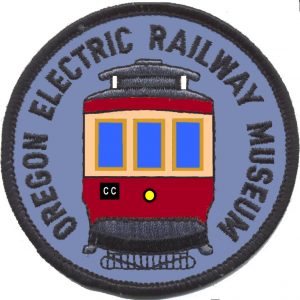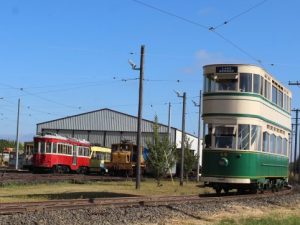-----
 |
| The OERM Logo (OERHS) |
The Oregon Electric Railway Museum was first formed in 1957 with a similar intent to its counterpart in Southern California: To preserve the rapidly-disappearing streetcars all around the Oregon area. The "Oregon Electric" part is no coincidence, as the founders wanted to pay homage to one of the Northwest's own interurban lines.
The organization started as the Oregon Electric Railroad Historical Society in 1959, with their first headquarters on a segment of a disused logging railroad originally owned by the Consolidated Timber Company in Glenwood, Oregon (40 miles outside Portland). The sawmill was reappropriated as a 4-track carbarn and that same year, Sydney Car No. 1187 was the first to call the new "Trolley Park" home.
Into the Sixties, more preserved streetcars began to call the Glenwood Trolley Park home, including British Columbian interurban No. 1394, "Broadway" Master Unit 4012 (originally 813), a Blackpool double-decker tram, and, uniquely, Portland "sweeper" 1455, an example of a streetcleaning streetcar that also doubled as a snowplough. The entire line was a 1.7 mile stretch covering 26 acres.
By the 1970s, the collection gained its biggest acquisitions yet in the form of five ex-Montana Freight steeplecabs from Missoula, MT. An Angelino even made it way up in the form of ex-Los Angeles Transit Lines 1318, an H3-type from 1923, but was too narrow-gauged to operate. Unfortunately, by the time the Council Crest cars 503 and 506 arrived, the line was further dilapidated.
In 1987, following Southern Pacific's abandonment of the "Jefferson Street" line through Lake Oswego, the ICC's cancellation gave the city of Portland to form a consortium that would purchase the line for future transit use. Lake Oswego, Trimet, and Clackamas and Multnomah Counties made up this consortium and later that year on September 12, the OERHS was granted a trial run of a heritage streetcar to drum up interest in the line. The line never had any wires as part of an electric railway, so an electric generator car was created to provide the juice needed.
Blackpool double-decker No. 48 would open the new line as the Willamette Shoreline Trolley, with the Portland Terminus at Moody Avenue and Lake Oswego's just one half-mile north of Downtown. The entire line would run for five miles, much larger than Glenwood Trolley Park which the OERHS was planning to abandon anyway. The line had gotten so delapidated and small that many of the cars (including the Council Crests) were suffering moisture damage so a new site had to be found.
Luckily, the Antique Powerland Museum in Brooks, Oregon, had enough room to add the large collection onto their property. The last car would run at Glenwood in 1995, with the new Oregon Electric Railway Museum opening at Powerland in 1996. Though still possessing one mile of track and overhead, the museum had enough room to add in a new Brussels tram and work car fleet in 2015, as well as ex-MUNI PCCs, a Fresno Birney, and more Mount Hood and Portland repatriates in the 1990s. The museum continues to operate well into today, with the biggest weekend being the Great Oregon Steam-Up in late July/early August.
-----
 |
| The original Glenwood Trolley Park carbarn (Steve Morgan) |
Into the Sixties, more preserved streetcars began to call the Glenwood Trolley Park home, including British Columbian interurban No. 1394, "Broadway" Master Unit 4012 (originally 813), a Blackpool double-decker tram, and, uniquely, Portland "sweeper" 1455, an example of a streetcleaning streetcar that also doubled as a snowplough. The entire line was a 1.7 mile stretch covering 26 acres.
 |
| Ex-Montana Freight L401 (OERHS) |
By the 1970s, the collection gained its biggest acquisitions yet in the form of five ex-Montana Freight steeplecabs from Missoula, MT. An Angelino even made it way up in the form of ex-Los Angeles Transit Lines 1318, an H3-type from 1923, but was too narrow-gauged to operate. Unfortunately, by the time the Council Crest cars 503 and 506 arrived, the line was further dilapidated.
In 1987, following Southern Pacific's abandonment of the "Jefferson Street" line through Lake Oswego, the ICC's cancellation gave the city of Portland to form a consortium that would purchase the line for future transit use. Lake Oswego, Trimet, and Clackamas and Multnomah Counties made up this consortium and later that year on September 12, the OERHS was granted a trial run of a heritage streetcar to drum up interest in the line. The line never had any wires as part of an electric railway, so an electric generator car was created to provide the juice needed.
 |
| Blackpool No. 48 at its new home on the Willamette Shoreline Trolley, with generator towed behind (Steve Morgan) |
Luckily, the Antique Powerland Museum in Brooks, Oregon, had enough room to add the large collection onto their property. The last car would run at Glenwood in 1995, with the new Oregon Electric Railway Museum opening at Powerland in 1996. Though still possessing one mile of track and overhead, the museum had enough room to add in a new Brussels tram and work car fleet in 2015, as well as ex-MUNI PCCs, a Fresno Birney, and more Mount Hood and Portland repatriates in the 1990s. The museum continues to operate well into today, with the biggest weekend being the Great Oregon Steam-Up in late July/early August.
 |
| Blackpool 48, now retired from the Willamette Shore Trolley cruises past the Brooks carbarn, with Milan Interurban 96 and Montana Freight Motor L401 at left (OERHS) |
Thank you for riding with us on this new and strange journey into 2020. Next month, we cover the Seattle and Tacoma streetcars! Ride safe!

No comments:
Post a Comment